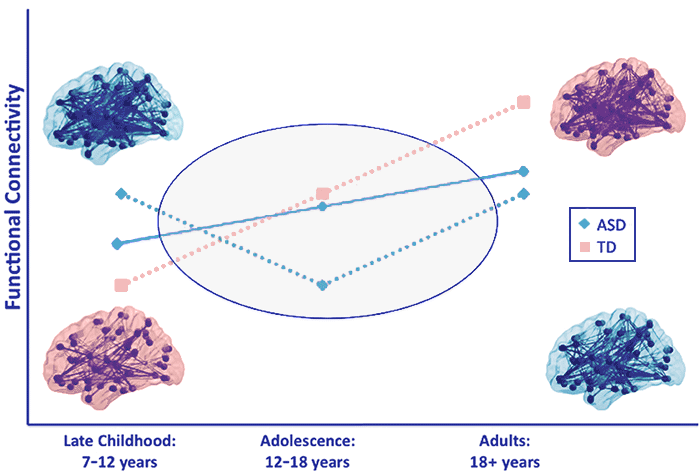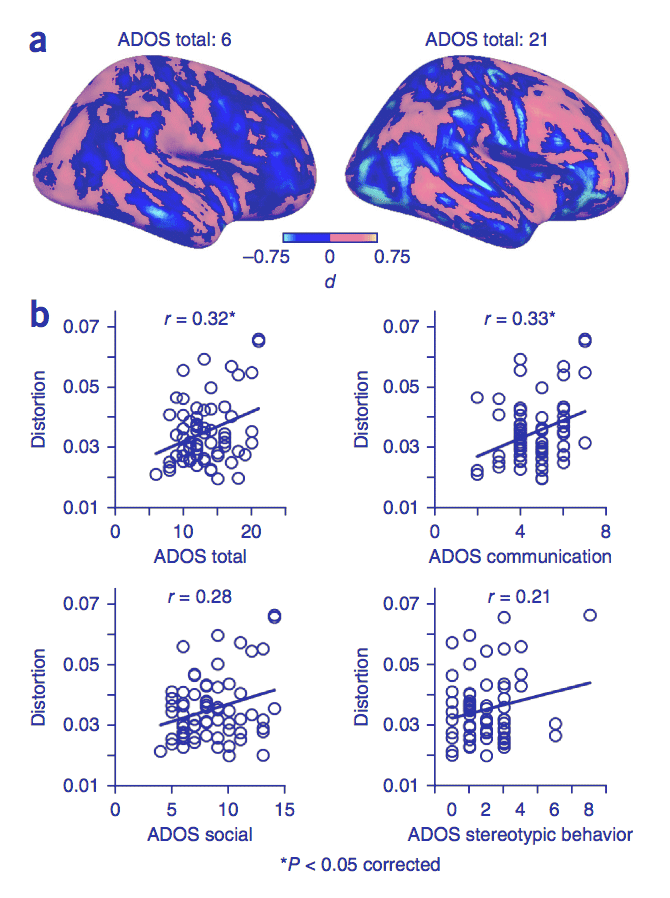Every non-autistic brain is (roughly) like every non-autistic brain.
But no autistic brain is like any other autistic brain.
Human Connectome Project
Since July 2009 scientists have been working on the Human Connectome Project.[1]NIH Launches the Human Connectome Project to Unravel the Brain’s Connections The aim of the project is to build a neural network map (connectome), meaning a map of all the connections in a person’s brain. Many of these connections form and are reinforced as a result of experiences we go through, and together they make up our memories, our personality, and our skills.

The project’s goal is to get a better understanding of the anatomical and functional connectivity of the human brain, as well as to produce a body of data that will facilitate research into conditions such as dyslexia, schizophrenia, Alzheimer’s disease, and indeed autism.[2]Mind mapping: Inside the brain’s wiring[3]Human brain mapped in unprecedented detail
Connectopathy
Research has indicated that some neurological disorders—or rather neurological differences*—emerge as a result of so-called connectopathies,[4]Disconnection Syndromes, Connectopathies & Cross-Wiring[5]Network analysis and the connectopathies: current research and future approaches which comprise of aberrant neural connections or an unusual extent of neural connections. So we are talking about neural connections that deviate from the norm either in how they connect and/or function, or in amount (i.e. too few or too many neural connections).
- Read more on why some might argue it’s more proper to speak of neurological differences rather than neurological disorders here: Why is autism seen as a disorder?
Autism is characterized both by aberrant neural connections[6]Diffusion tensor imaging in autism spectrum disorders: preliminary evidence of abnormal neural connectivity[7]Abnormalities of intrinsic functional connectivity in autism spectrum disorders[8]Abnormal functional connectivity of default mode sub-networks in autism spectrum disorder patients[9]Abnormal cerebral effective connectivity during explicit emotional processing in adults with autism spectrum disorder[10]Self-regulation of brain oscillations as a treatment for aberrant brain connections in children with autism and unusual extent of neural connections,[11]Brain Hyperconnectivity in Children with Autism and its Links to Social Deficits[12]Hyperconnectivity of Local Neocortical Microcircuitry Induced by Prenatal Exposure to Valproic Acid[13]Hyperconnectivity of prefrontal cortex to amygdala projections in a mouse model of macrocephaly/autism syndrome[14]Cortical activation and synchronization during sentence comprehension in high-functioning autism: evidence of underconnectivity[15]Reduced functional connectivity between V1 and inferior frontal cortex associated with visuomotor performance in autism[16]Autism spectrum disorders: developmental disconnection syndromes[17]Autism: the first firm finding = underconnectivity?[18]Underconnected, but How? A Survey of Functional Connectivity MRI Studies in Autism Spectrum Disorders[19]Autism as a neural systems disorder: A theory of frontal-posterior underconnectivity and so it appears autism is one such connectopathy.[20]Connectopathy in Autism Spectrum Disorders: A Review of Evidence from Visual Evoked Potentials and Diffusion Magnetic Resonance Imaging
Connectivity in autism
While the research on brain connectivity in autism has been contradictory, demonstrating both hypoconnectivity (i.e. a lack of connections) in some studies,[21]Cortical activation and synchronization during sentence comprehension in high-functioning autism: evidence of underconnectivity[22]Reduced functional connectivity between V1 and inferior frontal cortex associated with visuomotor performance in autism[23]Autism spectrum disorders: developmental disconnection syndromes[24]Autism: the first firm finding = underconnectivity?[25]Underconnected, but How? A Survey of Functional Connectivity MRI Studies in Autism Spectrum Disorders[26]Autism as a neural systems disorder: A theory of frontal-posterior underconnectivity and hyperconnectivity (i.e. a lot of connections) in others,[27]Brain Hyperconnectivity in Children with Autism and its Links to Social Deficits[28]Hyperconnectivity of Local Neocortical Microcircuitry Induced by Prenatal Exposure to Valproic Acid[29]Hyperconnectivity of prefrontal cortex to amygdala projections in a mouse model of macrocephaly/autism syndrome connectome research has resolved this apparent contradiction by demonstrating that certain brain regions show high interconnectivity in autistics and comparatively reduced connectivity in neurotypicals, while other brain regions show lower connectivity in autistics and comparatively elevated connectivity in neurotypicals.
Analyzing fMRI scans from high-functioning autistic adults and non-autistics, certain regions had high interhemispheric (between the right and left sides) connectivity: primary sensory-motor regions like the sensorimotor cortex and the occipital cortex.
Others showed low interhemispheric connectivity: regions like the prefrontal cortex and temporal cortex, which are involved in higher order association.[30]The connections in autistic brains are idiosyncratic and individualized
Frontal cortex
Research from 2005 suggests connectivity within the frontal lobe is excessive (i.e. hyperconnected), disorganized, and inadequately selective, whereas connectivity between the prefrontal cortex and other systems is poorly synchronized, weakly responsive, and information impoverished.[31]Why the frontal cortex in autism might be talking only to itself: local over-connectivity but long-distance disconnection
Due to this local overconnectivity but reduced long-distance cortical activity, some impairments/differences emerge in:[32]Why the frontal cortex in autism might be talking only to itself: local over-connectivity but long-distance disconnection
- Higher-order social and emotional processing and communication
- Cognitive functions
- Orienting to and exploring the social and non-social world
- Speech
Research from 2008 indicates abnormal patterns of effective connectivity, with the prefrontal cortex being a key site of dysfunction in effective connectivity. According to these findings, abnormal long-range connectivity between structures of the “social brain” could explain the socio-emotional challenges that characterize autism.[33]Abnormal cerebral effective connectivity during explicit emotional processing in adults with autism spectrum disorder
Functional connectivity
However, this is not the whole story, because even research on the connectivity of the same brain regions can be contradictory; some studies indicate functional connectivity (the connectivity between brain regions that share functional properties) in certain brain regions is weaker in autistic individuals, leading to long-distance cortical “under-connectivity” theories of autism,[34]Why the frontal cortex in autism might be talking only to itself: local over-connectivity but long-distance disconnection[35]Autism spectrum disorders: developmental disconnection syndromes[36]Inter-regional brain communication and its disturbance in autism[37]Autism as a neural systems disorder: A theory of frontal-posterior underconnectivity but emerging evidence takes the under-connectivity models into question, and instead indicates that functional connectivity between brain regions can be stronger in autistic brains.[38]Salience network-based classification and prediction of symptom severity in children with autism
A paper from 2013 suggests the different findings stem from the subjects being in different stages of development; studies of autistic children under the age of 12 (pre-puberty) find considerable evidence for functional hyper-connectivity, while studies based on autistic adolescents and adults indicate functional hypo-connectivity.[39]Reconceptualizing functional brain connectivity in autism from a developmental perspective

The diagram above shows two possible scenarios of how functional connectivity evolves with age:[40]Reconceptualizing functional brain connectivity in autism from a developmental perspective
- In scenario 1 (solid blue line), the autism group shows a less steep developmental increase in functional connectivity over the age span compared with the TD group.
- In scenario 2 (dashed blue line), the autism group shows anomalous patterns of connectivity across the pubertal period.
Idiosyncratic brains
When researchers superimposed non-autistic brain scans on top of each other, the brains were all very similar. However, when the same thing was done to autistic brain scans, the autistic brains were all very different. The autistic brains all had areas of high and low connectivity, but no distinct areas of high and low connectivity were discernible.[41]The idiosyncratic brain: distortion of spontaneous connectivity patterns in autism spectrum disorder
In other words, autistic people have more individualized, idiosyncratic connectivity patterns than controls do; each autistic brain differed from the norm, but each did so in its own way.
In the diagram below you can see how the connectivity of autistic people and controls compare. Note the higher levels of inter-subject similarity between participants of the control groups in comparison to those of the autism groups.[42]The idiosyncratic brain: distortion of spontaneous connectivity patterns in autism spectrum disorder

These findings suggest that autism may be due to the way in which constituent parts of the autistic brain are interrelated, rather than due to hypo/hyperconnectivity in particular. So this points to aberrant neural connections of connectopathy rather than unusual extent of connections.
Connectivity & symptomatology
Research also indicates the deficits/traits that characterize autism in the core domains of communication, social, and stereotypic behavior—and the extent thereof—correlate with alterations in connectivity.[43]The idiosyncratic brain: distortion of spontaneous connectivity patterns in autism spectrum disorder

Presumably, this is also the case for our advantages; many of us have unique abilities that are not necessarily common among all people with autism, which correlate with particular brain regions and their (inter)connectivity.
So it seems each autistic brain is unlike any other autistic brain—in addition to being unlike a neurotypical brain. Perhaps this explains why autistic individuals interact with the world in a non-typical, unique way.
Comments
Let us know what you think!